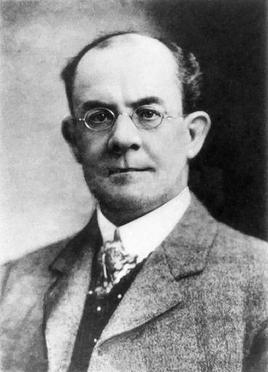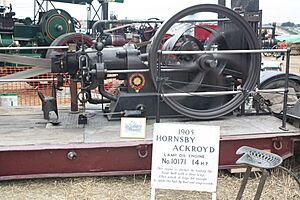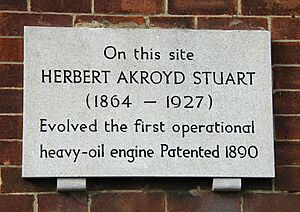Herbert Akroyd Stuart facts for kids
Herbert Akroyd-Stuart (born January 28, 1864 – died February 19, 1927) was an English inventor. He is famous for inventing the hot bulb engine, also known as the heavy oil engine. This type of engine was an important step in the development of modern engines.
Contents
Life of Herbert Akroyd-Stuart
Herbert Akroyd-Stuart was born in Halifax, Yorkshire, England. When he was young, he lived in Australia for a while. He went to school at Newbury Grammar School and later studied at Finsbury Technical College in London. His father, Charles Stuart, started a company called Bletchley Iron and Tinplate Works. Herbert joined his father's business in 1887.
How Oil Engines Were Developed
In 1885, something interesting happened to Akroyd-Stuart. He accidentally spilled paraffin oil (which is like today's diesel) into a pot of melted tin. The oil quickly turned into a gas and caught fire when it touched a paraffin lamp. This gave him an idea! He wondered if paraffin oil could be used to power an engine. Unlike petrol, paraffin oil was hard to turn into a gas in a carburettor.
His first test engines were built in 1886. In 1890, he worked with Charles Richard Binney. Together, they filed a patent for Richard Hornsby & Sons, a company in Grantham, England. The patent was for "Improvements in Engines Operated by the Explosion of Mixtures of Combustible Vapour or Gas and Air." One of these early engines was sold, but it was hard to start when cold. It needed extra heat to get going.
The Hornsby-Akroyd Engine
From June 26, 1891, Richard Hornsby & Sons started building Akroyd-Stuart's engines. They called them the Hornsby Akroyd Patent Oil Engine. These engines were first sold to the public on July 8, 1892. This was a big deal because it was the first internal combustion engine to use a special system to spray fuel under pressure.
The Hornsby-Akroyd engine worked differently from some other engines. It used a "vaporizer" or "hot bulb" on top of the engine cylinder. Fuel was sprayed into this hot bulb. The heat from the bulb would make the fuel-air mixture catch fire. To start the engine, the hot bulb needed to be heated with an outside flame, like a blowtorch. Once running, the engine's own heat kept the bulb hot. This design was simpler than some other engines of the time.
These "hot bulb" engines were made until the late 1920s. They were sometimes called "semi-diesels." They were not as fuel-efficient as later diesel engines, but they were simpler to build and use.
First Oil-Powered Train Engine
In 1896, Richard Hornsby and Sons built the world's first train engine (called a railway locomotive) that ran on oil. It was named LACHESIS and was made for the Royal Arsenal in Woolwich, England. They also built the first car powered by a compression-ignition engine.
Oil Engines Around the World
- Sweden: Similar engines were built by a company called Bolinder in Sweden. You can still find some of these engines in old canal boats today.
- United States: Hot bulb engines were also made in the USA by the De La Vergne Company in New York City. They bought a license to build the engines in 1893.
Akroyd Engine vs. Diesel Engine
Both the Diesel engine and the Akroyd engine use petroleum oil as fuel. This has led to discussions about whether the Diesel engine was based on the Akroyd engine. The Akroyd engine was the first working internal combustion engine that could use petroleum oil. It was running in 1891, which was six years before the Diesel engine first worked.
However, after the Diesel engine became successful, "Diesel engine" became a common name for any engine that ran on petroleum oil. Engines using the Akroyd design were then called "Semi-Diesel" engines. Because of this, Herbert Akroyd Stuart tried to get the name "Akroyd engine" used instead of "Diesel engine" in the early 1900s.
The main difference between the Akroyd and Diesel engines is how the fuel catches fire. In an Akroyd engine, a special hot part (the "hot bulb" or "vaporizer") starts the fire. This is because the engine's compression is not high enough to ignite the fuel on its own. A Diesel engine, however, does not need a separate hot part to start the fire. The fuel ignites because the air inside the cylinder gets extremely hot from being squeezed by the piston.
Because Diesel engines use much higher compression, they are more efficient. This means a Diesel engine uses less fuel to do the same amount of work compared to an Akroyd engine.
Later Life and Legacy
In 1900, Herbert Akroyd-Stuart moved back to Australia. He started a company called Sanders & Stuart with his brother Charles. He passed away on February 19, 1927, in Perth, Australia, from throat cancer. His body was brought back to England and buried in All Souls Cemetery in Boothtown, Halifax. His uncle, Edward Akroyd, had paid for the building of All Souls Church.
The University of Nottingham has held a special lecture in his memory, called the Akroyd-Stuart Memorial Lecture, since 1928. Famous inventor Sir Frank Whittle gave one of these lectures in 1946. Akroyd-Stuart had worked with Professor William Robinson, who was an engineering professor at University College Nottingham.
Akroyd-Stuart also left money to several important engineering groups. These funds created the Akroyd-Stuart Prizes, which are awarded every two years by the Institution of Mechanical Engineers, the Royal Aeronautical Society, and the Institute of Marine Engineering.
See also




